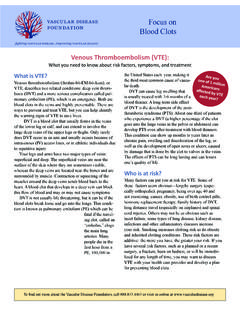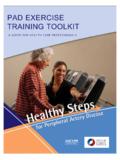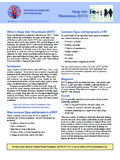Transcription of Foot Care and PAD - vasculardisease.org
1 life Saving tips About . foot care and PAD. Why is foot care important for foot care Plan: people with PAD? 4 Wash your feet each day with warm, not hot, people who have peripheral artery disease (PAD) are water and a mild soap or cleanser. Dry your feet gently and more likely to have foot problems. When the blood vessels well. Be sure to dry between the toes. in your feet and legs are narrowed or blocked by the buildup of fats (or plaque), not enough blood flows to these parts of 4 Keep the skin soft and smooth. the body. As a result, minor problems such as cuts, sores or Keep the skin soft and smooth. If your skin is dry, apply a blisters cannot heal quickly, or heal at all.
2 Thin coat of cream or lotion that does not have alcohol over people who have PAD and diabetes have an even great- the tops and bottoms of your feet, but not between the toes. er risk of foot problems. Not only do they have poor blood flow (or fighting circulation) to their feet and disease . VASCULAR legs but they improving ..also may 4 Trim your toenails VASCULAR HEALTH straight across and have nerve damage from high blood glucose (sugar) levels. file the edges. Rounded edges help prevent ingrown This problem is called diabetic neuropathy (ne-ROP-uh- toenails that can cause infections. If your nails are thick or thee). Nerve damage can cause you to lose feeling in your hard to trim, go to a health care provider to trim your toe- feet.
3 You may not feel a pebble inside your sock that is caus- nails. Ask your health care team to refer you to a foot care ing a sore, or you may not feel a blister caused by poorly provider who takes care of people with diabetes or people fitting shoes. with circulation problems in their feet or legs. Minor foot injuries in people with PAD and people with diabetes can cause sores or ulcers that can turn into serious infections. If these sores are not treated right away, 4 Check your feet every day. Look at the tops, bottoms and sides of your feet as well as between they may lead to losing a toe, foot or leg. In fact, PAD your toes.
4 Use a mirror or ask a family member or friend and diabetes are the leading causes of foot or leg amputa- to help if you have trouble seeing the bottoms or sides tions in the United States. of your feet. Use your hands to feel for hot or cold spots, The good news is that people with PAD can prevent se- bumps or dry skin. Check for: rious foot problems and amputations by taking care of their feet every day. If you have diabetes, taking care of your sores, cuts, bruises or breaks in the skin feet and keeping your blood glucose levels under control rashes also can help keep your feet safe. corns, calluses and blisters red spots and swelling ingrown toenails and toenail infections What can I do each day to take pain care of my feet?
5 Set aside the same time each day to take care of your feet. 4If you find any of these foot problems, Make foot care a part of your daily routine, just like brush- call your health care provider right away. ing your teeth. Follow this foot care plan to prevent minor Do not try to take care of cuts, sores or infections yourself. foot problems from becoming major ones. Post it on your Some over-the-counter foot care products can harm your bedroom or bathroom door to remind yourself to take care skin, making problems worse. of your feet. To find out more about the Vascular disease Foundation, call or visit us online at What other steps should I take to protect my feet?
6 Washing and checking your feet each day is the first part of your foot care plan. Follow these steps as well to protect your feet from serious problems. 4 Wear shoes and socks at all times. have diabetes, do not test bath water with your feet;. Never walk around in bare feet even indoors. Choose use your arm or hand to be sure the water is not too hot. socks that will not cause sores on your feet. They should be seamless socks or those with flat or soft seams. Wear 4 Keep the blood flowing to your feet. comfortable shoes that fit well and protect your feet. Put your feet up when sitting and do not cross your legs Before you put on your shoes, feel inside them to make for long periods of time.
7 If you have pain, dangle or sure the lining is smooth and that there are no pebbles wiggle your feet and toes to increase blood flow and or rough edges. If you have diabetes, keep in mind that decrease pain. If you smoke or use any type of tobacco you may not be able to count on the nerves in your feet product, ask your health care team for help in quitting. to feel something wrong with your shoes or socks. Nicotine reduces blood flow to your feet. 4 Choose shoes that will keep your 4 Be active every day. Ask your health care feet safe. When you buy new shoes, have a shoe team to help you plan a daily activity program that is expert make sure the size is right for your feet.
8 You may right for you. walking , dancing, swimming, and bicy- not be able to feel a short or narrow shoe. Because your cling are good forms of exercise that are easy on the feet often get wider as you get older, you may need to feet. Avoid activities that are hard on the feet, such as change shoe sizes over time. When you have new shoes, running and jumping. Always include a short warm-up wear them for only a few hours a day at first, and then and cool-down period. Wear athletic shoes that fit well change into other shoes for the rest of the day. This will and that provide good support. help you to avoid getting blisters or sores from new shoes.
9 If your health care team suggests wearing special What other steps should I take inserts in your shoes, make sure there is enough room in to protect my feet? At each office visit, your the toe box of the shoes you wear for the insert. If not, you health care provider should look at your feet. Once will need to buy shoes that have a deeper and wider toe you are in the exam room, take off your shoes and box. If you already have foot problems such as nerve dam- socks every time so that you are ready to have your age, Medicare or your private insurance may pay part of feet checked. If you have diabetes, you should have a the cost for special shoes or inserts.
10 Ask your health care complete foot exam at least once a year more often if team whether you can apply for these benefits. you already have foot problems. A complete foot exam should include a check of the skin on your feet, your 4 Protect your feet from hot and cold. foot muscles and bones, how well you can walk, your Wear socks at night if your feet get cold. Always wear blood circulation and whether you have any numbness shoes at the beach, the pool, or on hot pavement. If you in your feet. The Vascular disease Foundation Established in 1998, The Vascular disease Foundation (VDF) develops educational information and initiatives for patients, their families and friends, and health care providers regarding often ignored, but serious vascular diseases.









